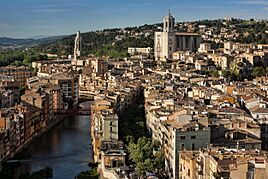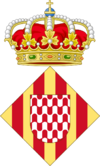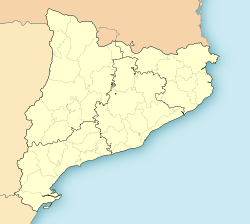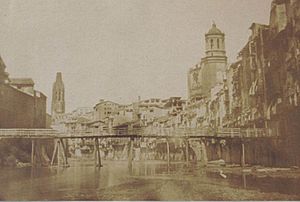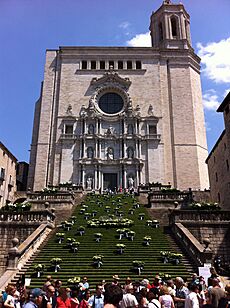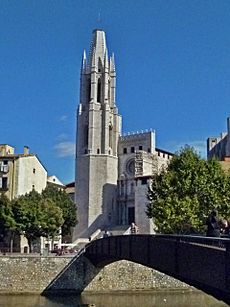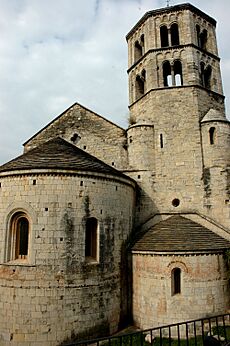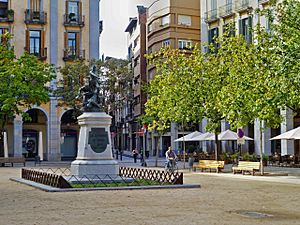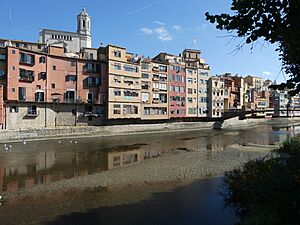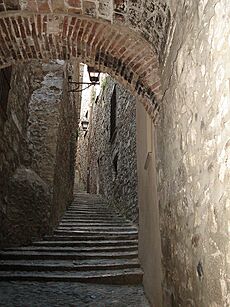Girona facts for kids
Quick facts for kids
Girona
|
|||
|---|---|---|---|
|
Municipality
|
|||
|
|||
| Country | Spain | ||
| Autonomous community | Catalonia | ||
| Province | Girona | ||
| Comarca | Gironès | ||
| Area | |||
| • Municipality | 39.1 km2 (15.1 sq mi) | ||
| Elevation
(AMSL)
|
76 m (249 ft) | ||
| Population
(2018)
|
|||
| • Municipality | 100,266 | ||
| • Urban | 156,423 (2,020) | ||
| Demonyms | Gironí, gironina | ||
| Area code(s) | +34 (E) + 972 (Gi) | ||
| Administrative divisions | 9 | ||
Girona is a beautiful city in Catalonia, Spain. It is the capital of the province of Girona. The city sits where four rivers meet: the Ter, Onyar, Galligants, and Güell.
In 2020, about 103,369 people lived in Girona. If you include the nearby town of Salt, the population is around 156,400. Girona is also the main city of the Gironès area. Many old parts of the city have been kept safe, making Girona a popular place for tourists to visit. It is located about 99 kilometers (62 miles) northeast of Barcelona.
Contents
History of Girona
The first people to live in this area were the Iberians. They called their city Gerunda. Later, the Romans built a fort here and kept the name Gerunda.
The Visigoths ruled Girona until the Moors took control in 715. But in 785, Charlemagne took it back. He made Girona one of the first fourteen counties of Catalonia. The Moors attacked and sacked Girona several times over the next centuries. In 878, Wilfred the Hairy made Girona part of the County of Barcelona.
In the 11th century, Girona became an official city. In 1351, King Peter III of Aragon made Girona a duchy for his oldest son, John. Later, in 1414, King Ferdinand I gave the title of Prince of Girona to his oldest son, Alfonso. Today, Princess Leonor holds this title.
Jewish Community in Girona
Girona had a Jewish community as early as 885. In the 12th century, this community became very important. It had one of Europe's leading schools for Kabbalah, which is a type of Jewish mysticism. The main Rabbi of Girona, Moshe ben Nahman Gerondi, became the Great Rabbi of Catalonia.
The Jewish community lived in a special area called the Jewish Call. In 1492, the Catholic Monarchs ordered all Jews in Spain to either convert to Christianity or leave the country. This event, known as the Alhambra Decree, ended Girona's Jewish community. For 400 years before this, the Jewish cemetery was located near the mountain Montjuïc, which means "hill of the Jews."
Sieges and City Walls
Girona has been attacked and besieged many times throughout its history—twenty-five times in total! It was captured seven times. For example, French armies attacked it in 1653, 1684, and twice in 1694.
During the Third siege of Girona in 1809, 35,000 French troops attacked the city. Girona bravely defended itself under Álvarez de Castro. But after months of heavy bombing, disease, and hunger, the city had to give up in December 1809.
At the end of the 19th century, the city walls on the western side were taken down to let the city grow. However, the walls on the eastern side were left untouched. In recent years, these missing parts of the eastern city walls have been rebuilt. Now, you can walk along the Passeig de la Muralla (Wall Walkway). It is a popular route for tourists around the old city.
Geography of Girona
Girona is located in a very important spot. It sits in a natural path between the Empordà plain and the Catalan Coastal Depression. This means it connects the northern Costa Brava and France by land with Barcelona and other cities to the south. This path is a narrow valley created by the Ter river between two mountain ranges.
The Ter river is the most important river in the area. It flows through the north of Girona. In Girona, the Ter meets the Onyar, which is the second largest river. The Onyar flows through the city from south to north. This river has shaped how the city grew over time. Sometimes, big floods from the Onyar have caused problems for the town.
Earthquakes in Girona
Girona is in an area where earthquakes can happen. This means it sometimes has small earthquakes throughout the year. Most of these are not felt by people. Some might feel like a small shake or vibration.
The strongest earthquake ever recorded in Girona was in 1428. It had a magnitude of 6.7.
Climate in Girona
Girona has a climate that is a mix of humid subtropical and Mediterranean climate. This means it has mild winters and hot summers. In winter, it often gets frosty (about 41 days a year from November to March). But it rarely snows. Winter temperatures can sometimes drop below -2°C (28°F).
The average yearly rainfall is usually a bit more than 700 millimeters (28 inches). The wettest times are autumn (September–November) and spring (April–early June). Thunderstorms can happen all year, but they are more common in summer. Even with rain, there is usually a dry period. This is why you see many drought-tolerant trees like oaks and pines around the city.
| Climate data for Girona Airport, 1981-2010 normals, extremes 1973-present | |||||||||||||
|---|---|---|---|---|---|---|---|---|---|---|---|---|---|
| Month | Jan | Feb | Mar | Apr | May | Jun | Jul | Aug | Sep | Oct | Nov | Dec | Year |
| Record high °C (°F) | 23.8 (74.8) |
25.5 (77.9) |
29.0 (84.2) |
30.2 (86.4) |
37.3 (99.1) |
43.0 (109.4) |
41.3 (106.3) |
41.2 (106.2) |
37.0 (98.6) |
33.1 (91.6) |
30.0 (86.0) |
22.5 (72.5) |
43.0 (109.4) |
| Mean daily maximum °C (°F) | 13.1 (55.6) |
14.1 (57.4) |
16.7 (62.1) |
18.8 (65.8) |
22.4 (72.3) |
26.6 (79.9) |
30.1 (86.2) |
29.8 (85.6) |
26.1 (79.0) |
21.8 (71.2) |
16.6 (61.9) |
13.6 (56.5) |
20.8 (69.5) |
| Daily mean °C (°F) | 7.1 (44.8) |
7.9 (46.2) |
10.4 (50.7) |
12.5 (54.5) |
16.3 (61.3) |
20.4 (68.7) |
23.6 (74.5) |
23.4 (74.1) |
20.1 (68.2) |
16.2 (61.2) |
10.9 (51.6) |
7.8 (46.0) |
14.7 (58.5) |
| Mean daily minimum °C (°F) | 1.1 (34.0) |
1.7 (35.1) |
4.1 (39.4) |
6.2 (43.2) |
10.1 (50.2) |
14.3 (57.7) |
17.1 (62.8) |
17.0 (62.6) |
14.1 (57.4) |
10.5 (50.9) |
5.2 (41.4) |
2.0 (35.6) |
8.6 (47.5) |
| Record low °C (°F) | −13.0 (8.6) |
−8.2 (17.2) |
−5.8 (21.6) |
−3.0 (26.6) |
0.6 (33.1) |
5.1 (41.2) |
8.0 (46.4) |
8.4 (47.1) |
4.6 (40.3) |
−2.0 (28.4) |
−7.0 (19.4) |
−9.4 (15.1) |
−13.0 (8.6) |
| Average precipitation mm (inches) | 62 (2.4) |
51 (2.0) |
50 (2.0) |
67 (2.6) |
71 (2.8) |
60 (2.4) |
32 (1.3) |
46 (1.8) |
70 (2.8) |
88 (3.5) |
70 (2.8) |
56 (2.2) |
728 (28.7) |
| Average precipitation days (≥ 1 mm) | 4.9 | 4.9 | 5.1 | 7.1 | 7.3 | 5.1 | 3.2 | 5.1 | 6.5 | 6.4 | 5.2 | 4.7 | 65.8 |
| Average snowy days | 0.3 | 0.3 | 0 | 0 | 0 | 0 | 0 | 0 | 0 | 0 | 0 | 0.1 | 0.7 |
| Average relative humidity (%) | 75 | 73 | 70 | 69 | 68 | 63 | 59 | 65 | 70 | 75 | 76 | 76 | 71 |
| Mean monthly sunshine hours | 147 | 156 | 179 | 194 | 224 | 247 | 285 | 261 | 195 | 167 | 143 | 132 | 2,330 |
| Source: Agencia Estatal de Meteorología | |||||||||||||
Main Sights and Attractions
Girona is a popular place for tourists. Many people visit from Barcelona, which is a short train ride away. The old part of the city is on a steep hill east of the Onyar river. The newer part is on the flat land to the west. Girona also has some beautiful Art Nouveau buildings.
Girona Cathedral
The Cathedral is a very important building in Girona. It was once a mosque when the Moors ruled. After they left, it was rebuilt. The current building is a great example of Catalan Gothic architecture.
You have to climb ninety steps to reach it. Inside, the main hall (nave) is very wide, one of the widest in any church. It has beautiful decorations, including a silver altarpiece. The cathedral also holds the tombs of important historical figures like Ramon Berenguer II, Count of Barcelona.
Old City Walls
The old city walls are another popular sight. These walls were very important for protecting Girona from invaders for hundreds of years. The first wall was built by the Romans in the 1st century BC. It was later rebuilt and strengthened in the 14th century.
Over time, parts of the wall were changed or removed as the city grew. But the walls on the eastern side stayed. Today, you can walk along these walls and climb the lookout towers. From the towers, you get amazing views of Girona and the countryside around it.
Sant Feliu Church
The Collegiate Church of Sant Feliu is interesting to see. It was built in the 14th-century Gothic style. Its front (façade) was added in the 18th century. This church is one of the few in Spain with a real spire. Inside, you can find the tomb of its patron saint and the tomb of the brave Álvarez. There is also a chapel dedicated to St. Narcissus.
Sant Pere de Galligants Monastery
The Benedictine church of the Sant Pere de Galligants monastery is built in an early Romanesque style. It dates back to about 1130. However, the monastery itself is even older, from around 950. It was built a little before the Monastery of St. Daniel.
Plaça de la Independència
The Plaça de la Independència, or Independence Square, is one of Girona's most famous and busy squares. It is in the city center. The square is also called Plaça de Sant Agustí, named after an old convent. Its current name refers to the 1808–1814 War of Spanish Independence against Napoleon Bonaparte.
The square is known for its 19th-century look. It is surrounded by similar-looking buildings with arches. These buildings honor the people who defended Girona during the sieges of 1808 and 1809. Today, the square is full of life with many cafés and restaurants.
Houses on the Onyar River
A special feature of Girona is the colorful houses that overlook the Onyar river. These houses were built over many years. They give the city a charming, Mediterranean feel. Their bright colors were chosen by local artists and architects.
One of these houses is Casa Masó. It was the birthplace of the famous architect Rafael Masó. It is a great example of the Noucentisme style in Girona. Since 2006, it has been home to the Fundació Rafael Masó. You can spot its unique white color from the river.
Jewish Heritage Quarter
Today, Girona's historic Jewish quarter, called the Call, has been restored. After the Jewish community was forced to leave in 1492, new houses were built over the old ones. When the dictator Francisco Franco died in 1975, people became interested in the city's history again.
During excavations, they found old buildings, including the home of Nahmanides. This house was bought by the city in 1987. You can see a rectangular mark on a doorway on Carrer de Sant Llorenç. This mark once held a mezuzah, a small scroll with religious texts. The Centre Bonastruc ça Porta is located on Carrer de la Força. It is built on the site of a 15th-century synagogue. This center now houses the Girona Museum of Jewish History and the Nahmanides Institute.
Culture and Sports
Sports in Girona
Girona is a popular place for professional cyclists to live and train. Many non-European pro cyclists have made Girona their home. They train on the excellent roads outside the city.
In 1997, American cyclists like Marty Jemison, Tyler Hamilton, and George Hincapie moved to Girona. They were part of the US Postal Service Professional Cycling Team. This started a trend, and later, famous cyclists like Lance Armstrong also lived in the city.
Football (soccer) is also very popular here. The local team is Girona FC. In 2017, they were promoted to La Liga, Spain's top football league. In December 2023, they even beat FC Barcelona for the first time in a league match. The team plays at Estadi Montilivi.
The city also has a roller hockey team called GEiEG. It is one of the best teams in Spain and plays in the main league, OK Liga.
Education
Girona is home to the Jaume Vicens Vives Secondary School. It also has the Universitat de Girona, which is a university.
Economy and Transport
Transport in Girona
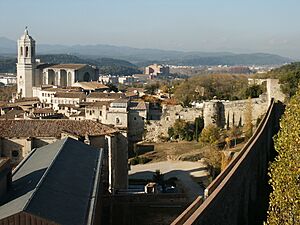
Roads
Girona is located on the Autopista AP-7 highway and the N-II road. The city is also a central point for local roads that go to the coast and inland towards the Pyrenees mountains.
Buses
The city has a good public bus service run by private companies. There are also buses that connect Girona to other towns in the province and long-distance buses.
Trains
Girona has a new train station west of the Old Town. You can take regular trains from here to Barcelona and to the French border.
Girona is also an important stop for high-speed AVE trains. These trains connect Girona to Paris, Marseille, Toulouse, and Figueres. They also go to Barcelona and Madrid. A train ride to Barcelona takes about 37 minutes on the AVE. To Madrid, it takes about 3 hours and 45 minutes.
Airport
The city's airport, Girona-Costa Brava, is about 10 kilometers (6 miles) south of the city center. It became very busy when Ryanair used it as a main base. However, Ryanair later moved most of its flights to Barcelona El Prat airport.
Girona Airport is about a 30-minute bus ride from Girona city's bus and train station. It is about an hour from Barcelona city center. Many low-cost airlines often mention "Barcelona" when describing Girona airport.
Notable People from Girona
- Maria Pilar Bruguera Sábat (1906–1994), a Roman Catholic nun and doctor.
- Josep Maria Corredor i Pomés (1912-1981), a person who promoted culture.
- Carme García (born 1974), a visually impaired skier and journalist.
- Fidel Roig Matons (1887–1977), a Catalan painter and musician.
- Miguel Molina (born 1989), a racing driver.
- Josep Maria Nadal i Farreras (1949–), a scholar of the Catalan language.
Sister Cities
Girona is twinned with these cities:
|
|
- Girona is also part of the Eurotowns network.
See also
 In Spanish: Gerona para niños
In Spanish: Gerona para niños


